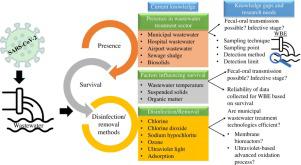Journal of Environmental Chemical Engineering ( IF 7.4 ) Pub Date : 2020-08-05 , DOI: 10.1016/j.jece.2020.104317 Pubali Mandal 1 , Ashok K Gupta 1 , Brajesh K Dubey 1

|
Severe acute respiratory syndrome coronavirus 2 (SARS-CoV-2) caused the global pandemic coronavirus 2019 disease (COVID-19). The outbreak of COVID-19 as Public Health Emergency of International Concern is declared by World Health Organization on January 30, 2020. The known route of transmission is due to direct contact or via respiratory droplets. Recently, several studies reported SARS-CoV-2 ribonucleic acid (RNA) in wastewater treatment plant samples. The presence of SARS-CoV-2 RNA in wastewater may predict COVID-19 occurrence qualitatively and quantitatively. The concept is known as wastewater-based epidemiology (WBE) or sewage epidemiology. The present study reviewed the presence of coronavirus in wastewater and investigations relating to WBE development as a tool to detect COVID-19 community transmission. Few articles reported a correlation of SARS-CoV-2 RNA concentration in wastewater with the number of COVID-19 cases, whereas few reported higher prediction by wastewater surveillance than confirmed cases. The application of WBE is still in a preliminary stage but has the potential to indicate an early sign of transmission. The knowledge of persistence of coronavirus in municipal and hospital wastewater is needed for the application of WBE and to understand the chances of transmission. The studies reported more prolonged survival of coronavirus in low-temperature wastewater. Studies relating to the inactivation of coronavirus by disinfectants and removal of coronavirus are also presented. Research on the performance of the commonly adopted disinfection technologies in inactivating SARS-CoV-2 in municipal and hospital wastewater is required to reduce the risk associated with municipal and hospital wastewater.
中文翻译:

废水中冠状病毒的存在、存活、消毒/去除方法及废水流行病学进展综述。
严重急性呼吸综合征冠状病毒 2 (SARS-CoV-2) 引起全球大流行冠状病毒 2019 疾病 (COVID-19)。世界卫生组织于 2020 年 1 月 30 日宣布新型冠状病毒肺炎 (COVID-19) 疫情为国际关注的突发公共卫生事件。已知的传播途径是直接接触或呼吸道飞沫传播。最近,多项研究报告了废水处理厂样本中存在 SARS-CoV-2 核糖核酸 (RNA)。废水中 SARS-CoV-2 RNA 的存在可以定性和定量地预测 COVID-19 的发生。这个概念被称为基于废水的流行病学(WBE)或污水流行病学。本研究回顾了废水中冠状病毒的存在以及与 WBE 开发相关的调查,作为检测 COVID-19 社区传播的工具。很少有文章报道废水中 SARS-CoV-2 RNA 浓度与 COVID-19 病例数的相关性,而很少有文章报道废水监测的预测结果高于确诊病例。 WBE 的应用仍处于初步阶段,但有可能表明传播的早期迹象。应用 WBE 并了解传播机会需要了解冠状病毒在市政和医院废水中的持久性。研究报告称,冠状病毒在低温废水中的存活时间更长。还介绍了有关消毒剂灭活冠状病毒和去除冠状病毒的研究。需要对常用消毒技术灭活市政和医院废水中 SARS-CoV-2 的性能进行研究,以降低与市政和医院废水相关的风险。











































 京公网安备 11010802027423号
京公网安备 11010802027423号